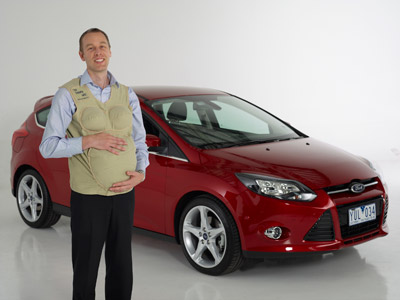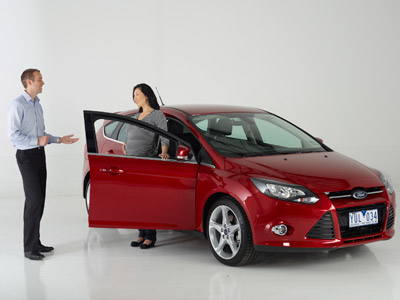David Stanley Ford Pregnancy Suit Interview

David Stanley Ford Pregnancy Suit Interview
Ford has brought to Australian shores a unique safety technology it has developed to make its vehicle's safer for mothers-to-be start struggling to fit comfortably - and above all, safely - into their cars. Meet the Ford Pregnancy Suit.
What is the technology?
Developed by Ford, the Pregnancy Suit has been specially designed to allow ergonomic engineers to experience firsthand how pregnancy can affect drivers and the problems pregnant women face when driving a vehicle, such as awkwardness in body movements, postural changes, shifts in centre of gravity and limitations in reach.
The Pregnancy Suit consists of lead weights to simulate the weight of the baby, a 'belly' containing 2kg of water, and a weighted pouch on the underside of the belly that simulates the foetal head resting and applying pressure on the bladder.
Interview with David Stanley
Question: What inspired Ford to create the Ford Pregnancy Suit?
David Stanley: The Pregnancy Suit has been specially designed to allow ergonomic engineers to experience firsthand how pregnancy can affect drivers and the problems pregnant women face when driving a vehicle, such as awkwardness in body movements, postural changes, shifts in centre of gravity and limitations in reach. Ford wants to ensure optimum comfort and usability for pregnant drivers.
Question: What did you learn by wearing "The Empathy Belly"?
David Stanley: I was able to experience firsthand some of the effects of pregnancy; such as an approximate 13.6kg weight gain (and associated backache), through the lead weights, 2 kg water bladder and weighted pouch on the underside of the belly that simulates the foetal head. The water bladder also allowed me to experience the increased pressure on the bladder. Finally, I was also able to feel the shortness of breath through the rib belt.
Question: What ergonomic challenges do pregnant women face in regards to a vehicle?
David Stanley: Changes in their centre of gravity, restrictions in movement, stepping in and out of the vehicle becomes difficult due to the height of the vehicle (bending down becomes problematic) and the position of the steering wheel. Seat comfort becomes paramount, and there needs to be a balance struck between the egress and ingress in regards to the seat bolster.  Question: How has Ford addressed these challenges and provided a solution with their cars?
Question: How has Ford addressed these challenges and provided a solution with their cars?
Question: In regards to safety, how are these cars safer for pregnant women?
David Stanley: Ford engineers and builds all of its vehicles with a high degree of passive and active safety features - from ultra-high-strength steel used in the construction of our vehicles to the anti-lock braking systems and dynamic stability control systems that enhance on-road driver safety. The empathy belly is just one of many devices used in the development of our vehicles to make sure we deliver the safest vehicles to our customers.
Question: Can you talk us through how every expectant mother should correctly buckle up?
David Stanley: Wearing Your Seatbelt Correctly - Make sure that your seatbelt is positioned below your abdomen, across your hips. The shoulder strap should be between your breasts, and make sure to tug on the belt to make sure it's nice and snug.
Move Back - Move your seat back to a comfortable distance when you are driving. Reclining the seat slightly can also help. Doing this will protect your stomach in the event of an airbag deployment.
Support Your Back -If you have pregnancy related back pain, place a small circular back pillow to support your lower back or use a rolled up towel. This will help increase comfort while you're driving.
Take a Break - If you're driving for a lengthy period, take regular breaks to increase blood flow to your feet. Feet and ankle are prone to swelling and it can worsen by sitting for long periods. Take a break to gently move your feet around, rotate your ankles, and wiggle your toes.
Be the Passenger - When possible, be a passenger. Sitting in the backseat is the safest spot in the car for an expectant mother. If you sit in the front seat, make sure to push the seat back as far as you can to protect from airbag deployment.
Have Your Information -Wherever you go, make sure to bring a long your pregnancy record card, which includes a detailed list of medical information, test results, and emergency contacts.
Question: How can Australians be especially mindful of pregnant mums on the roads?
David Stanley: Be mindful that their ability to twist and turn to look over their shoulder when changing lanes or parking may be impaired. As well, their ability to swerve quickly may also be restricted. Remember they are carrying precious cargo!
Question: What's next for Ford?
David Stanley: Ford is committed to delivering industry-leading smart technology solutions that enhance the driving experience for its drivers, and deliver the highest quality vehicles on the road today. We are always looking at what we can do to roll- industry-leading smart technology solutions for Australian drivers.
Interview by Brooke Hunter
MORE
- Rack It Range Extensions
- Lunch Style 2016
- Nicholas Demos Solving Life Issues Online...
- Warm Up With DeLonghi This Winter
- Chill Out Chair
- Spring 2014 Dulux
- in.cube8r
- Forty Winks: Buyer's Guide To Bedding
- Ageing In One's Own Home
- European Apothecary Sea Salt Candle
- Survey Reveals Housework Wars Behind Closed Doors



